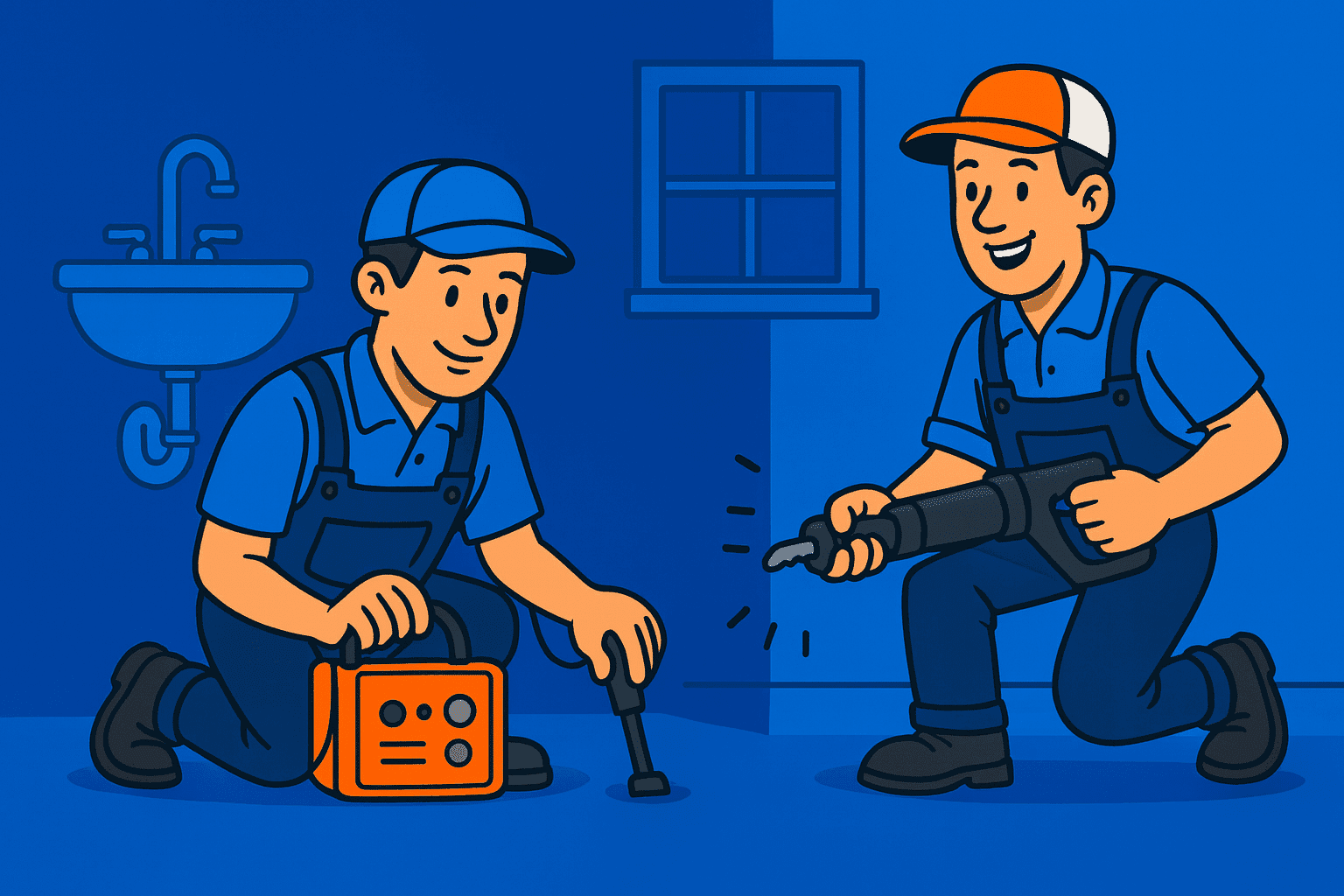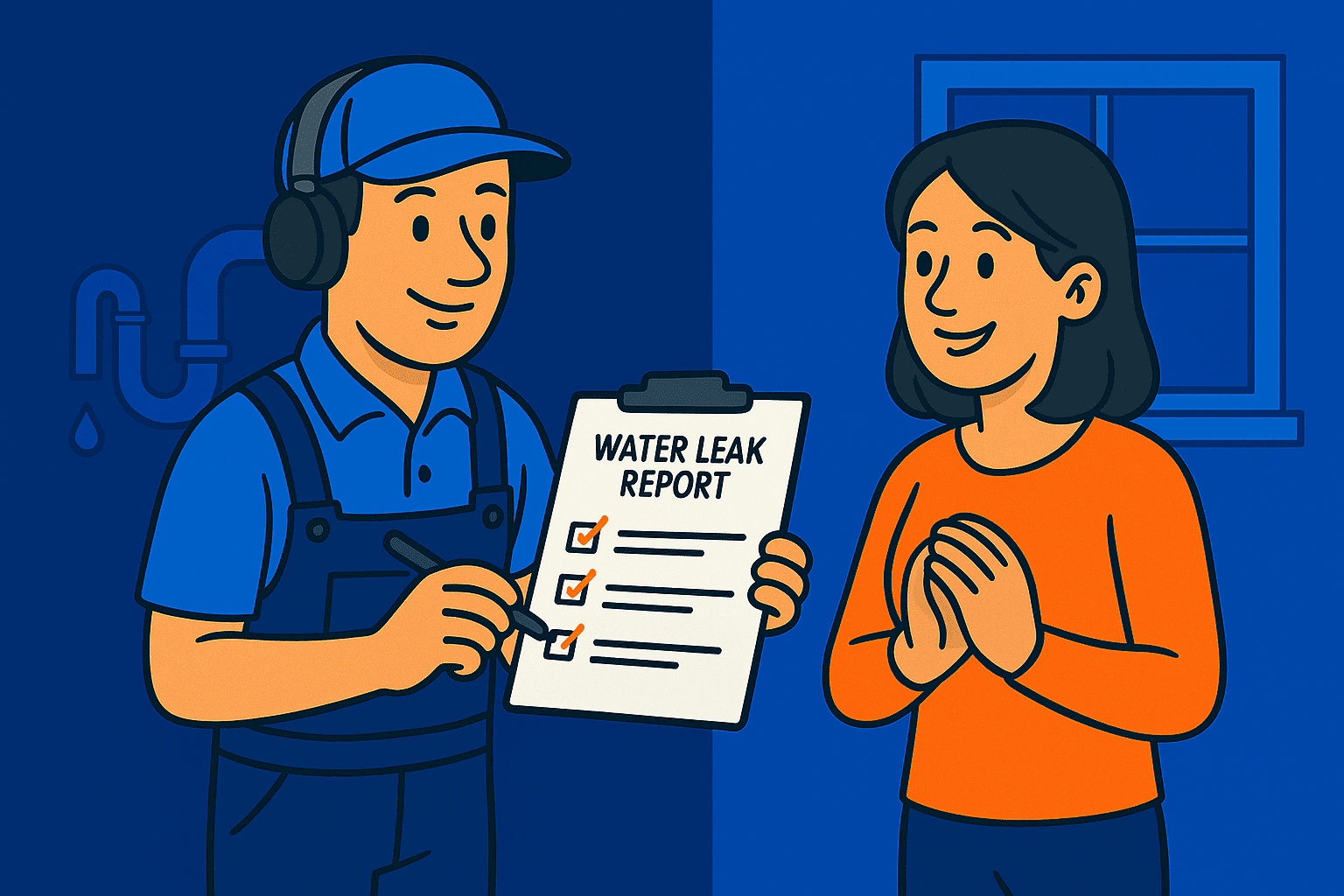Trace and Access Plumber Services
Trace and Access Services in Cornwall and Devon. Reliable leak tracing, access and repairs 🤝
Contact Us About Trace And Access
Fast Reply Within 15 secs – 20 mins 🚀
↓ START THE PROCESS NOW ↓
What Is Trace and Access? Understanding the Process
Right, let’s cut through the jargon. Trace and access is simply finding where water’s escaping from your pipes (that’s the ‘trace’ bit) and getting to it for repairs (the ‘access’ part). After four decades in this business, I’ve seen homeowners waste thousands because they didn’t understand this crucial service.
“In my 30+ years of leak detection, I’ve found that 85% of water leaks are hidden behind walls, under floors, or in places you’d never think to look. That’s why proper trace and access techniques are essential – we save you from unnecessary destruction and costs.”
Here’s what trace and access leak detection actually means for you: instead of ripping up your entire bathroom floor hoping to find a leak, we use specialist equipment to pinpoint exactly where the problem is. Think of it like keyhole surgery for your plumbing – minimal damage, maximum results.

Thermal imaging reveals hidden leaks
Why Trace and Access Leak Detection Matters for Your Property
Most people only discover they need trace and access services when their water bill suddenly doubles or they spot a mysterious damp patch. By then, the damage might already be extensive. Trace and access leak detection prevents small problems becoming disasters.
According to Water Regulations UK, undetected leaks waste approximately 3 billion litres of water daily across the UK. That’s not just bad for the environment – it’s money literally going down the drain.
Our thermal imaging cameras can detect temperature variations as small as 0.1°C, revealing water leaks invisible to the naked eye. This technology means we can trace leaks through multiple layers of construction materials without any demolition work.
Our Trace and Access Process: How We Find Hidden Leaks
Over the years, I’ve developed a systematic approach that works. No guesswork, no unnecessary damage – just methodical leak detection using the best equipment available. Every trace and access investigation follows our proven six-step process, refined through four decades of experience.
Initial Assessment
We start with a thorough property inspection. I’ll ask about your water usage, check visible pipework, and look for tell-tale signs most people miss. This initial assessment often reveals clues about where to focus our search.
Non-Invasive Detection
Using specialist equipment, we listen for the distinctive sound of escaping water. Our acoustic leak detection methods for precise results can detect leaks through concrete, wood, and even soil.
Thermal Imaging Survey
Our thermal cameras reveal temperature differences caused by water leaks. Cold water shows up distinctly against warmer surroundings, making hidden leaks visible without any damage to your property.
Tracer Gas Testing
For particularly elusive leaks, our tracer gas leak detection for hard-to-find leaks introduces a safe, non-toxic gas into the pipe system which escapes at the leak point, where our sensitive detectors pick it up.
Precise Access
Once located, we access the leak with minimal disruption. Often, we need to remove just a single tile or make a small opening – nothing like the destruction you’d face without proper detection.
Comprehensive Reporting
We document everything with photos, videos, and detailed reports. This evidence is crucial for insurance claims and gives you peace of mind that the problem’s been properly identified.
Trace and Access Costs: What Affects the Price?
Let me be straight with you – trace and access costs vary considerably depending on several factors. While I can’t give you a specific figure without seeing your property, I can explain what influences the price so you know what to expect.
Key Cost Factors:
- Leak complexity: A simple leak in accessible pipework costs far less than our underground water leak repairs to prevent structural issues
- Property size: Larger properties require more time and equipment to survey thoroughly
- Detection methods needed: Simple thermal imaging is less expensive than multiple techniques like acoustic listening plus tracer gas
- Access requirements: Removing a floor tile differs vastly from excavating concrete
- Location: Our slab leak detection services for concrete foundations typically costs more due to access complexity
- Urgency: Emergency callouts naturally carry premium rates
- Insurance involvement: If you have trace and access cover, your insurer may dictate specific requirements
Note: Most residential trace and access investigations range from a few hundred to several thousand pounds, depending on these factors. We always provide a clear quote before starting work.
Trace and Access Insurance: Making Successful Claims
Here’s something many homeowners don’t realise – trace and access cover is often included in your buildings insurance, typically up to £5,000. But getting a successful claim requires proper documentation and procedure.
What Trace and Access Insurance Covers
Your trace and access insurance typically covers:
- The cost of detecting the leak using specialist equipment
- Accessing the leak location (removing flooring, tiles, etc.)
- Making good the access damage (but not the actual pipe repair)
- Professional reports and documentation
What’s NOT Covered

Insurance-ready documentation
Understanding exclusions prevents nasty surprises:
- The actual repair of the leaking pipe (covered under buildings insurance)
- Water damage from the leak (separate claim under escape of water)
- Leaks from external sources or poor maintenance
- Gradual damage you should have spotted earlier
Our detailed reports include everything insurers need: photographic evidence, thermal imaging results, moisture readings, exact leak location coordinates, and recommended repair methods. This comprehensive documentation typically results in faster claim processing and fewer disputes.
We maintain relationships with all major UK insurers and understand their specific requirements. Many loss adjusters know our work and trust our reports, which often speeds up the claims process. We can even liaise directly with your insurer if you provide authorisation.
“I always tell clients – document everything. Take photos before we start, during the process, and after. Keep all invoices and reports. In 30+ years, I’ve never seen a properly documented trace and access claim rejected.”
Types of Leaks We Detect with Trace and Access
Central Heating Leaks
Central heating systems often develop pinhole leaks in pipework. Our central heating leak repairs to restore warmth uses pressure testing and thermal imaging, accessing pipes with minimal disruption to your décor.
Swimming Pool Leaks
Pool leaks waste thousands of litres daily. Our swimming pool leak repairs to maintain your pool uses specialist dyes and pressure testing to find leaks in pipes, liners, and structures.
Underfloor Heating Leaks
Our underfloor heating leak repairs to restore your system uses thermal imaging to map the entire system and pinpoint the exact leak location without destroying your floors.
Mains Water Leaks
A mains water leak can cost hundreds in wasted water. Our mains water leak repairs to protect your supply traces the supply pipe route and locates leaks precisely, often saving you from excavating your entire drive.
Gas Leaks
While primarily water specialists, our gas leak detection services for safety and compliance ensures your property is secure. Safety is paramount – we use calibrated detectors to find and report any gas leaks.
Commercial Properties
Our commercial property leak solutions for businesses minimises business disruption. We work outside hours and provide detailed reports for insurance and compliance purposes.
Why Choose DCI as Your Trace and Access Experts?
I’ve been in this business since 1985. That’s four decades of finding leaks others couldn’t, saving properties from unnecessary damage, and helping thousands of homeowners across Cornwall and Devon. Here’s what sets us apart:
30+ years Experience
Established 1985
Fully Insured
£2M Public Liability
Insurance Approved
Reports Accepted
Getting Started with Trace and Access
If you suspect a water leak, don’t wait. What seems like a minor issue today could be causing significant damage behind the scenes. Here’s what to do:
- Check your water meter: Turn off all taps and appliances. If the meter still moves, you likely have a leak
- Document any visible signs: Photograph damp patches, mould, or damage
- Contact your insurer: Check if you have trace and access cover
- Call a specialist: Whether through insurance or privately, get professional help
Remember, trace and access leak detection near me searches might show many options, but experience matters. You want someone who’s seen it all and knows exactly where to look.
Book Your Trace and Access ServiceServing Cornwall & Devon’s Major Towns and Cities
Based in Saltash, Cornwall, we provide trace and access plumber near me services throughout Cornwall and Devon. Our central location means we can respond quickly to emergencies across both counties.
Areas We Cover for Trace and Access
Don’t see your area? Call us – we often travel further for larger projects or can recommend trusted partners in your region.
Need a Trace and Access Plumber in Cornwall?
Don’t let a hidden leak damage your property. With 30+ years experience and the latest detection equipment, we’ll find your leak quickly and professionally.
Call Now: 07822 025 911 Email: hello@dcileakdetection.co.ukFrequently Asked Questions
What does trace and access mean in leak detection?
Trace and access refers to the process of locating (tracing) a hidden water leak in your property and then creating access to it for repairs, all with minimal damage to your home. In Cornwall’s older properties with stone walls and clay soils, this often involves non-invasive methods like thermal imaging to avoid unnecessary excavation.
Is trace and access covered by home insurance?
Most UK buildings insurance policies include trace and access cover up to £5,000-£10,000, which pays for the detection and access costs but not the actual pipe repair. Always check your policy details, as exclusions may apply for poor maintenance or gradual leaks. We provide insurance-approved reports to support your claim, having helped hundreds of Cornish homeowners successfully reclaim costs.
How much does trace and access cost in Cornwall?
Trace and access costs typically range from £500-£2,000 depending on property size, leak complexity, and methods required. For a standard Cornish cottage, basic thermal tracing might cost £400-£650, while underground mains leaks needing tracer gas could reach £1,200. We offer fixed-price quotes after a free survey, with no hidden fees – often fully reclaimable via insurance.
What methods do you use for trace and access leak detection?
We employ non-destructive techniques including thermal imaging cameras (detecting 0.1°C differences through walls), acoustic listening devices for pipe sounds, tracer gas testing for buried leaks, and endoscope cameras for tight spaces. In Devon’s clay-heavy soils, tracer gas is particularly effective for underground detection without digging up your garden.
How long does trace and access take?
Most residential trace and access jobs in Cornwall take 2-6 hours, depending on the leak’s location. Simple wall leaks might be traced in under 2 hours, while complex underfloor systems could take a full morning. We aim for same-day completion where possible, minimising disruption to your daily routine.
Do you repair the leak after tracing it?
While trace and access focuses on location and access, we can often repair the leak on the same visit if it’s straightforward – like a simple pipe joint fix. For major repairs, we’ll provide a fixed quote and coordinate with your plumber or insurer. In 30+ years, we’ve found early repairs prevent secondary damage like mould in Cornwall’s damp climate.
Do you offer trace and access for commercial properties in Devon And Cornwall?
Yes, we handle commercial trace and access for businesses across Devon and cornwall, from Truro offices to Exeter warehouses. Our methods scale for larger systems, including slab leaks in concrete floors.
